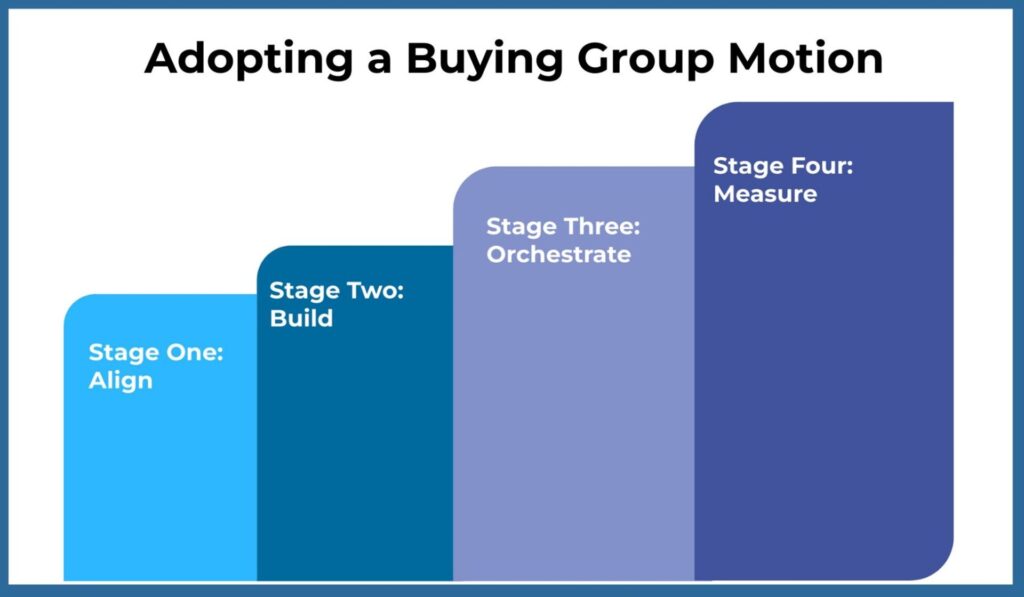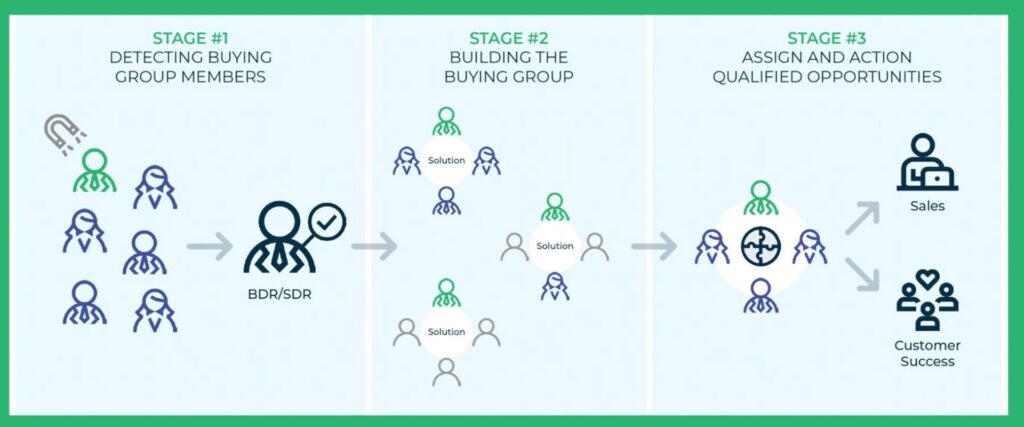This blog is a guest post from our friends at LeanData.
There’s a popular Goldilocks analogy gaining momentum in B2B sales and marketing circles that states:
Leads are too narrow.
Accounts are too broad.
Buying Groups are just right.
After years of Marketing throwing so-called “leads” over the fence to Sales, and account-based marketing (ABM) teams completely missing new buying centers within an account, it’s time for a go-to-market (GTM) revolution.
The primary motivator is, for many organizations, the B2B buyer is not one person, but a buying group composed of multiple players.
And, applying lead-centric or legacy ABM processes to members of a buying group results in a longer sales cycle, a poor buying experience, lead leakage and a waste of marketing investment. The better solution is a buying group motion where revenue teams focus on identifying, qualifying and moving opportunities through the sales cycle.
But how do you drive organizational change in systems and processes entrenched in leads?
Well, here’s your pitch …
Limitations of the MQL model
More and more sales and marketing teams are noticing that lead-centric processes are breaking down. Here are the all-too-familiar signs:
- Most opportunities are either closed-lost or recycled.
- Lead-to-opportunity conversion rates are low, wasting resources and spend.
- Opportunities have only one contact when there are obviously more people on the buying committee.
- The sales team has limited to no visibility into the engagement of the full buying team.
- Marketing teams are incentivized to deliver high lead volumes that don’t convert down the funnel.
Despite these problems, many companies are stuck on a hamster wheel of MQLs that don’t convert and don’t result in revenue.
Ultimately, MQLs should never be your source of truth or sole KPI. Rather, they are a leading indicator, a data point and a way for companies to identify priority leads. They are a dial to hone your messaging, processes and follow-up approach. By focusing on MQLs – and by-extension, leads – sellers often underestimate all the personas on the full buying committee. Essential context about the group making the buying decision is missing, including relevant buying signals. Simply stated, MQLs alone ignore the signals that matter.
Further, when focusing solely on leads and contacts, sellers can’t see the buyer overlap and the influence those disparate opportunities have on the account as a whole.
The answer lies in gathering signals from the entire buying group.
Your B2B buyer is a group
 According to Forbes, conventional wisdom believed the buying committee was around six people. In reality, buying committees are 10, 12, 14 people or more.
According to Forbes, conventional wisdom believed the buying committee was around six people. In reality, buying committees are 10, 12, 14 people or more.
Buying groups are similar to buying committees found in most ABM initiatives. In the context of GTM motions, a buying group is connected to a particular deal moving through a sales cycle. They have been assembled to solve a particular organizational problem.
Buying groups are made up of multiple departments, roles and personas which include subject matter experts, contributors from a relevant department and other stakeholders or gatekeepers.
While an individual’s department and persona are static, their role on the buying committee may change depending on the organizational problem the group is trying to solve.
Phases of a buying group GTM motion

There are five fundamental building blocks marketing and sales teams need to consider in a buying group motion:
- What solution(s) are applicable to the account?
- Who is in the buying group for each solution?
- What are the key roles and buying drivers?
- How can we connect these people and qualify them?
- How can we orchestrate the go-to-market motion?
Because of the organizational change involved in adopting a buying group motion, a phased approach is recommended. The timeline can be highly variable, depending on your organization’s readiness and motivation.
Phase 1: Align
The first phase in adopting a buying group motion is all about gaining organizational alignment. There must be a logical rationale for making this change and a clear explanation of its financial impact.
Phase 2: Build
In the build phase, processes and technology are set up to capture buying signals, prioritize them, and move existing opportunities forward.
Phase 3: Orchestrate
The steps and responsibilities in the orchestrate phrase are divided by the marketing, SDR/BDR and sales teams. Marketing will develop and optimize campaigns to attract and engage with members of the buying groups.
BDRs/SDRs identify buying group members, adding members to a suspect opportunity, and potentially scheduling meetings.
Sales and Marketing will collaborate throughout the entire opportunity cycle to ensure a cohesive approach to engagement.
Phase #4: Measure
In the measure phase, companies create reports and dashboards to evaluate the success of their buying group motion. Some suggested metrics include number of engaged buying group members, average buying group members at a qualified stage, or average buying group members who attended a meeting.

Using technology to operationalize a buying group motion
On a tactical level, a buying group motion is played out in three basic stages:
- Stage 1: In Stage 1 of a buying group motion, the primary focus is to detect buying signals from members of a buying group. Technology platforms capture various forms of buying signals, match leads to a single unique contact under the right account and surface contacts as members of marketing campaigns.
- Stage 2: In Stage 2, either through automation or working in conjunction with SDR/BDR teams, contacts are assigned to open opportunities as members of a buying group. Opportunities are qualified and prioritized. The opportunity may sit in an early stage until minimum qualifications are met.
- Stage 3: In Stage 3, qualified opportunities with a predefined minimum number of buying group members are sent to the appropriate sales team or channel, or even Customer Success, ready to be worked.
LeanData customers who have successfully transitioned to a buying group motion took two primary paths in regards to their tech stack: (1) re-architecting existing systems without adding any new tech and (2) reconfiguring existing systems as well as buying new tech.
Out with the old, in with the new
Navigating the transition from lead-centric and ABM strategies to a buying group GTM motion is admittedly no simple feat. It will require both a cultural and operational shift to adjust sales and marketing philosophies to make the shift.
On a high level, this transformation requires a thorough internal process evaluation, an understanding of industry best practices and data management strategies, and potentially the adoption of new technologies.LeanData customers using a buying group motion today report the following improvements:
- Less siloed departments
- Competitive advantage
- Decreased lead assignment time
- Shorter sales cycles
To investigate a buying group motion further, visit the LeanData Buying Groups Resource Center.




